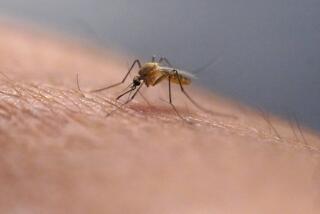Disease Stalks the Fox : Deaths From Distemper Could Imperil Area Dogs
MODJESKA CANYON — Since last April, Ralph “Bud” Matthews has trudged up the Santa Ana Mountains three times a week in search of foxes. Matthews is completing a research project on the gray fox, but in recent weeks the work has undergone a tragic metamorphosis:
The foxes, already imperiled by development, are facing a new threat.
With the deadline for his master’s thesis at Cal State Fullerton fast approaching, Matthews has determined that canine distemper is killing the gray fox of Modjeska Canyon and could endanger any dog in the vicinity that has not been vaccinated against the disease within the past year.
The validity of Matthews’ findings was underscored last week, when on Monday night, two distemper-ridden gray foxes were deposited at the doorstep of local animal control facilities.
“These came from Santiago Canyon, just up the road from Modjeska Canyon, and they were wandering around, slobbering all over the place,” said Richard H. Evans, chief of veterinary services for the Orange County Health Care Agency. “They were brought in by passersby who thought they had rabies, which is an easy mistake to make. But it was definitely canine distemper.”
In Matthews’ study, he set 80 traps that led to nine foxes being captured. Of those, he collared seven with radio transmitters that cost $250 apiece. Two of the seven were found dead in March, victims of distemper.
Of the five remaining foxes carrying radio transmitters, none has been found, Matthews said, and for the first time since the study began, their radio signals also have vanished, leading him to conclude that they too died of distemper.
Last week brought yet another strange development in what constitutes, at least for now, a perilous time for foxes in California. Animal control officials in Marin County in the Bay Area reported that 233 foxes and raccoons have turned up dead since Jan. 1, victims of what state Fish and Game Department officials said Friday is definitely canine distemper.
“We’ve had 45 dead foxes [this month],” said Jolie Levine, spokeswoman for the Marin County Humane Society. “In March of last year, we only had five.”
Foxes in the Bay Area are showing the same symptoms as the two deposited on Evans’ doorstep in Orange County: wandering about, showing an eerie absence of fear in the presence of humans and foaming profusely from the mouth.
When contacted, officials in Los Angeles, Ventura, Riverside and San Diego counties said last week that the incidence of distemper in their regions has been no higher than normal, although officials in San Diego reported distemper killing more skunks than usual in March.
So far, only foxes and raccoons have died in Marin County, Levine said, “with not a single case” reported among stray or domestic dogs.
Nevertheless, both Bay Area and Orange County authorities are urging pet owners to take “serious precautions.” Some canine diseases can be transmitted simply by a dog sniffing an infected animal, Levine noted.
Levine and other animal control officials say last year’s heavy rains led to a bumper crop of baby wildlife throughout the state. Those animals are now grown and, she said, might be crowding the ecosystem.
So, whatever disease appears to be claiming the foxes’ lives--in both Northern and Southern California--may be, in her words, “part of the natural order of things.”
Evans, who completed his master’s thesis on canine distemper among wildlife, said the sudden turn in Matthews’ Orange County study is hardly unusual.
A highly contagious disease that attacks an animal’s central nervous system, canine distemper is fatal among wildlife 90% of the time, he said, although it’s less so among domestic pets, which, through evolution, have developed a more combative resistance. Unlike rabies, with which it holds similar properties, distemper cannot be transmitted to humans.
“It’s in the measles family. In fact, it’s very akin to measles,” Evans said. “It’s basically a dog disease that is transferred easily to certain species of wildlife--coyotes, all species of foxes, even raccoons and skunks, which are actually quite susceptible. In my study, I documented one outbreak near St. Louis in 1981 that claimed 10,000 animals in a four-month period.”
Canine distemper has been more common in the foothills of Orange County in recent years, said Evans, who warned the guardians of domestic dogs: Get them vaccinated against distemper promptly, and if they haven’t received a “booster” shot within the past year, have them revaccinated immediately.
Otherwise, he said, their lives are at risk.
“The problem is one of spread,” Evans said. “We’d like to make sure that every dog in the region is vaccinated and protected. I hesitate to call this an outbreak, but it is a point of concern and one that needs to be addressed by everyone in the area.”
In conjunction with his yearlong master’s thesis, Matthews, 37, had placed the radio transmitters on seven gray foxes, which roam up to the 3,500-foot elevation of Laurel Spring, about five miles up the Harding Truck Trail from Tucker Wildlife Sanctuary, where Matthews and his wife reside.
“I noticed about mid-February that the foxes either weren’t moving or had simply disappeared,” he said. “I couldn’t pick up their radio signals.” On Feb. 29, he discovered a fox that wasn’t part of his study but which proved very easy to catch.
“It was extremely diseased,” he said.
Matthews’ mammalogy professor and mentor, Barry Thomas, took the fox to a pet clinic, where it soon died. Veterinarians removed its head and shipped it to Department of Fish and Game officials in Sacramento. By March 8, they had determined the fox died of distemper.
“They were able to do so,” Matthews said, “because of the lesions on the surface of its brain. Also, in the bladder there were cysts or growths. There were also lesions along its spinal cord.”
The gray fox is a 5- to 8-pound animal that, even under normal circumstances, clings to life in a shrinking environment. It once roamed the campus of Cal State Fullerton as well as the Anaheim Hills, Matthews said, but is losing its fragile hold to relentless urban sprawl.
Since last April, in anachronistic Modjeska Canyon, Matthews has studied the gray fox in six-hour shifts--6 p.m. to midnight, midnight to 6 a.m., 6 a.m. to noon.
But now, the subjects of his thesis, “The Activity Patterns of the Gray Fox in the California Chaparral,” are nowhere to be found.
“We’re not finding any more fox [feces] on the road, which is the biggest indication that there aren’t any foxes left,” he said. “In other words, we’re not finding evidence of any foxes. They’re just . . . gone.”
(BEGIN TEXT OF INFOBOX / INFOGRAPHIC)
A Deadly Virus
Health officials are warning residents in the canyons of eastern Orange County to keep dogs inside or fenced due to an outbreak of distemper among gray foxes. Normally, about two dozen cases of canine distemper are treated by the Orange County Humane Society each year. More facts on the disease:
WHAT IS DISTEMPER?
Distemper is a contagious, airborne virus of dogs and wild animals. It is not the same as rabies or feline distemper.
* Skunks, gray foxes and raccoons are the county’s main wildlife carriers
* It is not a disease of humans or cats
* Spreads through nasal contact with infected dog or other animal
* Affects mostly puppies and young dogs
* Fatal in about 90% of cases among wildlife, although the percentage is lower among domestic dogs
SIGNS, SYMPTOMS
Symptoms appearing within seven to 14 days of infection:
* Lethargy
* Loss of appetite
* Dazed, confused
* Discharge in eyes, nose
* Circling, convulsions
* Wildlife also shows no fear of humans
PROTECT YOUR PET
High immunization rates keep distemper outbreaks in urban areas a rare occurrence. In rural areas, where dogs often are not immunized, minor outbreaks are more likely to occur.
* Always immunize all dogs
* Isolate puppies from other young dogs until fully immunized
* Re-immunize as recommended by veterinarian
* Get booster shots if dog has had recent contact with wildlife
SUSPECT DISTEMPER?
Report recent contact with wildlife to Humane Society. If you think your dog or a wild animal has distemper, call the Orange County Humane Society at (714) 935-6931.
Sources: Orange County Humane Society and World Book Encyclopedia
More to Read
Sign up for Essential California
The most important California stories and recommendations in your inbox every morning.
You may occasionally receive promotional content from the Los Angeles Times.










